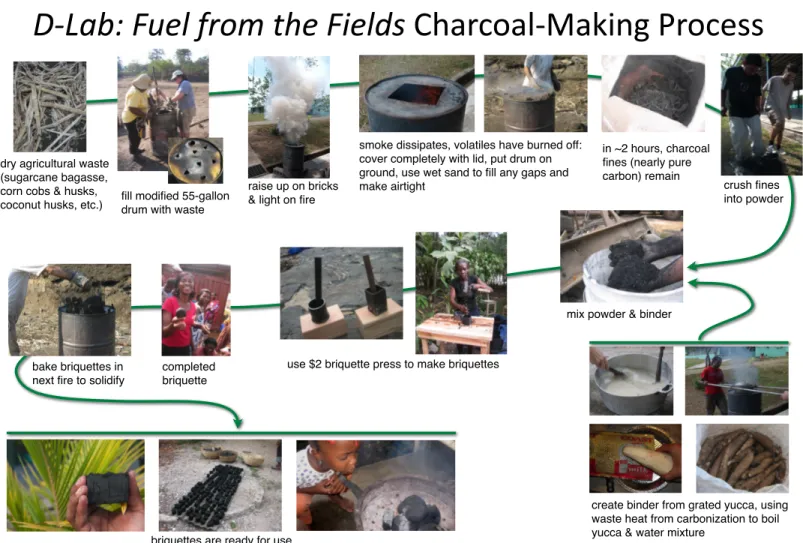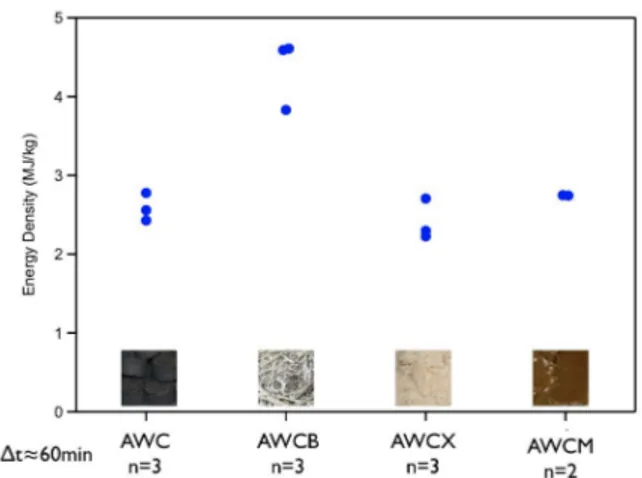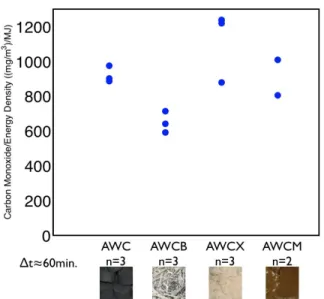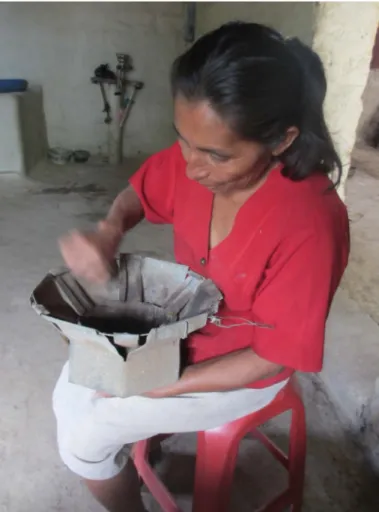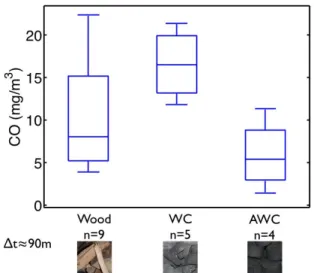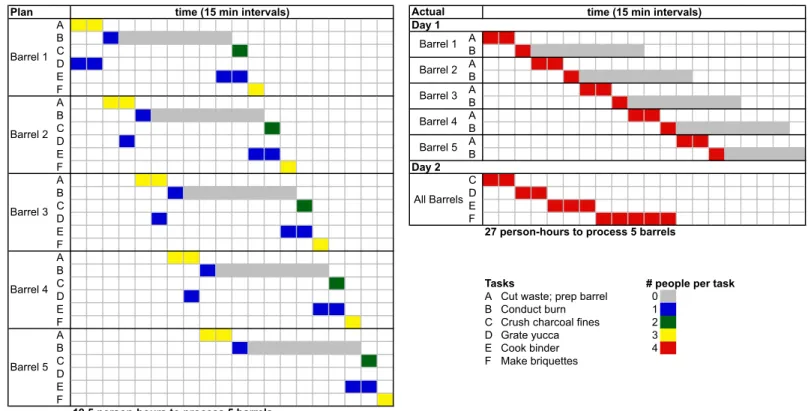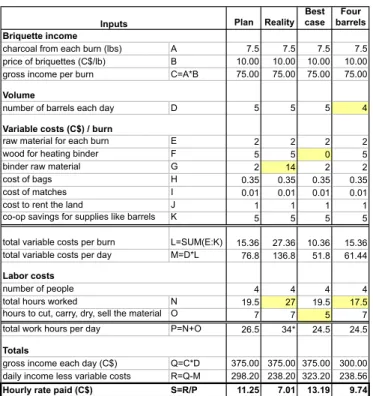Design of Agricultural Waste Charcoal
Cooking Fuel for Developing Countries
The MIT Faculty has made this article openly available.
Please share
how this access benefits you. Your story matters.
Citation
Banzaert, Amy, and Amos Winter. “Design of Agricultural Waste
Charcoal Cooking Fuel for Developing Countries.” Volume 4:
18th Design for Manufacturing and the Life Cycle Conference;
2013 ASME/IEEE International Conference on Mechatronic and
Embedded Systems and Applications (August 4, 2013). © 2013 by
ASME.
As Published
http://dx.doi.org/10.1115/DETC2013-12219
Publisher
American Society of Mechanical Engineers (ASME)
Version
Final published version
Citable link
http://hdl.handle.net/1721.1/108067
Terms of Use
Article is made available in accordance with the publisher's
policy and may be subject to US copyright law. Please refer to the
publisher's site for terms of use.
DESIGN OF AGRICULTURAL WASTE CHARCOAL COOKING FUEL FOR
DEVELOPING COUNTRIES
Amy Banzaert∗
Wellesley Engineering Laboratory Wellesley College
Wellesley, MA 02482 Email: abanzaert@wellesley.edu
Amos Winter, V
Department of Mechanical Engineering Massachusetts Institute of Technology
Cambridge, MA 02139 awinter@mit.edu
ABSTRACT
Charcoal made from agricultural waste (AWC), intended for use in developing countries, has the potential to be a cooking fuel with health, economic, and environmental benefits. Investiga-tions were undertaken to integrate the technical understanding of the fuel with the real-world context in which it may be produced and used. Multiple formulations of AWC were studied to under-stand the impact of raw material variation on charcoal briquette emissions. A key finding is the viability of manure as a binder, which should improve AWC production costs and proliferation. In Nicaragua, AWC emissions, end user interest, and producer economic viability was examined. Emissions of AWC appear to be similar to or less than wood and wood charcoal. End user interest seems moderate, a positive outcome given the lack of charcoal usage in the region studied. Based on the outcomes of pilot production, development of the manufacturing system must account for local preferences.
INTRODUCTION
Traditional biomass-based cooking fuels — wood, charcoal made from wood, agricultural waste, and dung — are responsi-ble for a number of critical proresponsi-blems in developing countries [1]. Used by nearly 40% of the world’s population, these fuels are re-sponsible for 1.3 million deaths each year associated with indoor air pollution [2]. Use of biomass for cooking is also known to
de-∗Address all correspondence to this author.
grade the environment locally, through deforestation, and glob-ally, as the associated emissions have been shown to contribute 20% of the world’s atmospheric black carbon [3]. Further, fam-ilies who collect biomass fuel can spend up to four hours a day doing so [4]; for families purchasing fuel, the cost can require 10-20% of the household budget [5].
Many interventions have tried to address these health, en-vironmental, and economic challenges. Household changes in-clude improving airflow within the kitchen, adding chimneys to stoves, separating all living areas from the kitchen to reduce smoke exposure, changing cooking behaviors, and introducing cookstoves that burn more cleanly and/or more efficiently [4]. Fuel changes include expansion of the electric grid [6], introduc-tion and subsidizaintroduc-tion of liquid propane gas [7, 8], introducintroduc-tion of biogas [9], and direct alternatives to traditional biomass.
One incarnation of this last approach is the development of a method for making charcoal briquettes from agricultural waste. The process of making agricultural waste charcoal (AWC) was developed by Amy Smith, founder and director of MIT’s D-Lab [10], with numerous colleagues and students including the author [11–17]. The Fuel from the Fields (FftF) process and required equipment, shown in Fig. 1, have been designed to be as simple and inexpensive as possible.
The expectation is that the FftF approach is appropriate for individuals, families, or small cooperatives in developing regions where there is good access to biomass waste, underemployment, and widespread use of solid fuels. Producers could both make
Proceedings of the ASME 2013 International Design Engineering Technical Conferences and Computers and Information in Engineering Conference IDETC/CIE 2013 August 4-7, 2013, Portland, Oregon, USA
!"#$%&'()*+',-./'01*'(2*+34!"#$%&'$()*$+,-.!/%'&011
dry agricultural waste (sugarcane bagasse, corn cobs & husks, coconut husks, etc.)
raise up on bricks & light on fire
smoke dissipates, volatiles have burned off: cover completely with lid, put drum on ground, use wet sand to fill any gaps and make airtight
mix powder & binder
bake briquettes in next fire to solidify
briquettes are ready for use fill modified 55-gallon
drum with waste
in ~2 hours, charcoal fines (nearly pure carbon) remain
crush fines into powder
completed briquette
use $2 briquette press to make briquettes
create binder from grated yucca, using waste heat from carbonization to boil yucca & water mixture
FIGURE 1: FUEL FROM THE FIELDS CHARCOAL PRODUCTION PROCESS.
AWC for their own use and sell it in the marketplace as an income-generating activity. The equipment required for produc-tion costs on the order of US$30, a modest investment when com-pared to larger kilns and automated briquetting machinery.
The intent of AWC is to provide a cooking fuel that ad-dresses the economic, environmental, and health issues of most solid fuels, while being easy to adopt both from an end user and a producer standpoint. Initial analyses show that AWC has promise in these realms [18].
In this paper, four investigations into the viability of AWC are presented, in which the understanding of AWC from a lo-cal producer, end user, and combustion emissions perspective is deepened and used to inform research quantifying how certain AWC combustion emissions vary depending on the “recipe” used to create the AWC. Such an appreciation of the real-world usage and production within the cultural context is crucial to effectively design both the AWC product and the associated manufacturing process.
FORMULATION OPTIMIZATION
Based on feedback from and production methods used by end users in the field, certain formulations of AWC were tested in order to understand how variation in the fuel’s inputs would affect the emissions and performance of the briquettes.
Methodology
The test matrix is shown in Tab. 1. The two raw materials tested — corn stalks and sugarcane bagasse — have been iden-tified by D-Lab staff and students in numerous specific locations worldwide as readily available and currently unused.
Binder was varied in two ways. Briquettes made with 50% more yucca-based binder than the typical recipe (documented in [18]) were studied to understand whether the additional raw material in the briquettes would adversely affect emissions. Ma-nure was also studied as a possible binder, given that many end users have asked whether that waste could be used as a binder. The initial instinct was to avoid manure binder, given the well-documented toxicity of emissions from dung exclusively used as fuel [19–21]. However, since binder is typically only 10% of a
TABLE 1: AWC TEST MATRIX. raw material raw material corn bagasse yucca AWC AWCB 50% extra yucca AWCX manure AWCM binder
briquette by weight, and since yucca is a somewhat problematic binder given that it is generally not free and is a food, the value of testing manure seemed evident.
Tests were conducted in a combustion chamber that was largely modeled after a test hood developed by The Engines and Energy Conversion Lab at Colorado State University Fort Collins [22]. The chamber is connected to a general ventilation suction blower that provides 0.03 m3/s flow out of the chamber. The CO measurements were made with a Bacharach ECA450 Combustion Efficiency and Environmental Analyzer [23]. A TSI DustTrak II Aerosol Monitor 8530 was used to measure total sus-pended particles (TSP) emitted. A LI-COR LI-840A CO2/H2O
Analyzer was used for carbon dioxide measurements. A K-type thermocouple attached to a Lascar EL-USB-TC-LCD data log-ger measured the temperature of the water in the pot that was placed on the stove for each study [24].
Measurements were taken from a port about one meter downstream from the curve in the ductwork. This curve was a limitation of the laboratory facility used. A Fox mini-eductor (611210-015-SS), driven by a motive flow of 400 Pa of gaseous nitrogen, was used to draw samples into a dilution chamber, to which the aerosol monitor was connected [25]. A dilution cham-ber was utilized because the particle monitor had maximum ex-posure thresholds well below the level of particles produced by the fuels tested.
A modified version of the Water Boiling Test (WBT) was used for all experiments [18, 26]. One liter of water (1000±0.5 grams) and 300±5 grams of fuel was used for each test. The chosen measurements allowed for calculation of the energy den-sity of a given fuel, based on amount of water boiled and fuel consumed, and to determine the average toxin concentration for
FIGURE 2: COMPARATIVE ENERGY DENSITY EMIS-SIONS FOR AWC OPTIMIZATION.
CO and TSP, two products of incomplete combustion known to be highly hazardous to health [27].
To determine the average toxin concentration, measure-ments were integrated over the time period studied, as shown in Eq. 1, where T is the total time period studied, n is the number of data points collected, Xnis the measured toxin for the given time
period, and tnis the time period over which Xnwas measured.
Average Toxin Concentration (g/m3) = 1 T
n
∑
i=1Xn∆tn (1)
Results and Discussion
The comparative energy density of the fuels is shown in Fig. 2. The energy density was calculated from measurements of the amount of water boiled and the weight of fuel combusted. All formulations appear similar, apart from the sugarcane-based charcoal (AWCB). When sugarcane charcoal fines are crushed, the resulting particles are noticeably finer than that of corn stalk charcoal. As smaller particles allow for improved compression, a resultant increased energy density for these briquettes is unsur-prising.
The comparative carbon monoxide emissions normalized to energy emitted are shown in Fig. 3. The differences between the fuels here also align with the understanding of the different fuels, particularly the expectation that a denser briquette would produce less CO because of improved combustion characteristics of the denser fuel. While the fuel with extra binder (AWCX) is not statistically different from the typical fuel (AWC) or from that made with manure (AWCM), with further repetitions it may be shown to emit more CO/MJ due to the extra binder, which is uncarbonized material in the briquette.
The comparative particulate matter emissions are shown in Fig. 4. The extra particulate emissions associated with the
bri-FIGURE 3: COMPARATIVE CO/MJ EMISSIONS FOR AWC OPTIMIZATION.
FIGURE 4: COMPARATIVE PARTICULATE MATTER EMIS-SIONS FOR AWC OPTIMIZATION.
quette with extra binder are unsurprising, based on the argument presented in the results for carbon monoxide.
There are a few important outcomes from the AWC formu-lation analysis. First, using a manure binder does not seem to adversely affect emissions. The ability to use manure as a binder may allow many more people to produce charcoal, and others to do so more affordably. Second, using only the quantity of binder specified, and not adding additional binder, is important for
com-FIGURE 5: TYPICAL ADOBE STOVE. Note the two holes on the top surface for cooking pots, the cracked chimney at the far end of the stove, and the front of the stove where logs of wood are loaded.
bustion emissions. Third, the energy density and CO emissions of the corn-based briquettes may improve if it is possible to crush that material more fully and/or compress those briquettes with greater force.
IN COUNTRY FUEL EMISSIONS
Emissions tests were performed in kitchens in Nicaragua to document the combustion emissions associated with cooking fu-els, particularly the fuel most commonly used in Nicaragua — wood — as compared to Nicaraguan wood charcoal and agri-cultural waste charcoal under local cooking conditions. Kitchen emissions testing was conducted using a convenience sampling method of seven kitchens in Sabana Grande, a village south of Ocotal, Nicaragua. All kitchens had an adobe wood stove as the primary cooking appliance; a representative example of this type of stove is shown in Fig. 5. Some of the stoves tested had improvements, such as chimneys or steel plate burners (rather than open holes), to reduce smoke emissions into the kitchens. For cooking with charcoal, all test subjects used their own rudi-mentary charcoal stove that they had constructed specifically for cooking with AWC [28]. A picture of this stove, which was placed on an unused section of the adobe stove for use, is shown in Fig. 6.
Experimental Design
The design of experiments for cooking emissions testing in the field was highly constrained by logistics. Very few pieces of equipment available were appropriate for use in the field: the devices needed to be robust to humidity, temperature, and
com-FIGURE 6: CHARCOAL STOVE. PHOTO REPRODUCED WITH PER-MISSION FROM ELISHA R. GOODMAN.
bustion gas and particle extremes without dilution, capable of surviving modest shocks due to the rigors of travel in remote re-gions, operate without access to electricity during testing, have minimal power requirements for battery charging, log data for at least eight hours continuously, and be small and light enough for transport over a two mile walk on rocky paths.
The three devices used for field testing were the TSI Dust-Trak II Aerosol Monitor 8530, a Lascar EL-USB-CO Carbon Monoxide (CO) Data Logger [29], and a Lascar EL-USB-2-LCD Temperature and Humidity Data Logger [30]. The two Lascar data loggers and the end of the length of conductive tubing con-nected to the inlet of the DustTrak were affixed to a stand that held the sensor inlets approximately 1.5 meters above the ground and 1 meter from the cookstove horizontally, as shown in Fig. 7. A second limitation of the experimental design was the con-straint on the choice of kitchens. Only certain women were available and/or willing to allow testing to occur in their homes. The time in the field was limited, preventing repeated measures.
FIGURE 7: FIELD EMISSIONS TEST SETUP. Note windows with privacy and security feature that limits airflow.
There was also notable house to house variation in terms of the stove itself and its household environment that likely affect emis-sions: cooking area, number of windows and doorways, chimney or lack thereof, and whether the kitchen was connected to the other room(s) of the house.
The other limitations of this work due to the use convenience sampling are primarily that the end users studied were somewhat educated about the health hazards associated with the emissions of cooking, which is not necessarily the case in other communi-ties in Nicaragua.
Results and Discussion
The aggregate results for emissions in all households for car-bon monoxide and TSP are shown in Figs. 8 and 9, respectively. Given the limitations described above, including the number of measures — indicated by the n-value in the figures — only pre-liminary trends can be documented. First, cooking with AWC in an unimproved cookstove appears comparable to cooking with
FIGURE 8: CARBON MONOXIDE EMISSIONS AGGRE-GATED FOR ALL HOUSEHOLDS.
FIGURE 9: TOTAL SUSPENDED PARTICLE EMISSIONS AGGREGATED FOR ALL HOUSEHOLDS.
wood on a stove with some improvements, such as a chimney. One would expect charcoal fuel to have fewer emissions than wood, as described by Ezzati et al. [31]. The similar emissions are likely due to the fact that the charcoal stove used had no chim-ney, while many of the wood stoves tested did.
END USER INTEREST
Although the economic, environmental, and health draw-backs of biomass cooking fuel are notable, introduction of al-ternatives is challenging due to a variety of barriers to change.
While the health impacts of indoor air pollution are severe, one cannot assume that end users are either aware of these health ef-fects or willing to spend the resources required to address the situation [32–36]. Similarly, the environmental costs associated with biomass usage are not well reflected in the price of the fuel. This reality is exacerbated by the fact that the wood used for cooking and for making wood charcoal is rarely harvested legally [37].
In addition, use of biomass for cooking persists even as households and countries gain wealth and access to additional fuel options. It is typical that more modern (and often more expensive) fuels are used for specific needs such as television or heating beverages, while biomass usage prevails for primary cooking and heating needs. Many households that use modern fuels extensively still maintain a biomass-based cooking option for cooking traditional staples such as bread and tortillas [38]. An awareness of food preferences and associated cooking habits is thus critical for implementing alternative cooking options.
Interview Design
Eight interviews were conducted with women in Sabana Grande in August 2011. The interviewees selected were all women because they are the family members who cook. Each interview took about 30 minutes and was conducted with a trans-lator familiar with both the interviewees and the purpose of the study. Additional informational interviews were conducted with a variety of people in Jinotega, a city in the north central region of Nicaragua, visited because wood charcoal is produced there. The most relevant findings from these interviews are presented here. Given that the interviews were conducted by the author, who is not native to the area, it is probable that courtesy bias was a factor in the interactions [39].
Basic Cooking and Kitchen Information
All women interviewed used adobe wood stoves that had one or two holes to hold pots and an additional hole meant for a chim-ney. Four of the women did not have chimneys attached to that hole. One explained that her family had a chimney previously but the chimney was too hard to clean and got blocked regularly so they dismantled it. When discussing making improvements to a stove, one women explained that a stove is like your child: you look after it and don’t change it.
In addition to the wood stoves, two women had gas stoves and four had solar ovens (that they built cooperatively through a program with GrupoFenix, a local community organization fo-cused on the development and implementation of renewable en-ergy technologies [40]). One of the gas stoves was not being used because the family lacked money for propane. The women with gas stoves used them to make rice and coffee; they preferred the wood stove for making beans and tortillas. Only one woman reported using her solar oven frequently.
The women all cooked three meals per day. The median number of people cooked for was six, the maximum was ten, and the minimum was two. They reported spending C$50-100/week on wood.1 Five of the women’s families also gathered some wood, representing 10–75% of their family’s fuel use.
The way in which the women used their stoves also varied. Two women preferred to keep their stove hot all day, adding fuel as needed. The remaining six preferred to let the fire go out after cooking and relight the stove when it was time to prepare the next meal. Each woman believed her behavior was the most efficient.
Charcoal and Other Alternative Fuels
All but one of the women interviewed had tried cooking with wood charcoal. They reported a range of experiences with the charcoal; only feedback that was mentioned by more than one in-terviewee is reported, with number of responses shown in paren-theses.
What they liked about charcoal: less smoky (6), easier to light than wood (4), gets hot fast (2), cooking was a lot faster (2), doesn’t go out as easily as wood (2), is handy to use when it rains (2). What they disliked about charcoal: too expensive (2), does not last long enough (2), charcoal is harder to light than wood (2). It is interesting that four women found charcoal easier to light than wood and two found it more difficult. The discrepancy may be a training issue or related to the difference in lighting ease for AWC and Nicaraguan wood charcoal (the latter is generally much harder to light than the former).
A notable outcome from the interviews is that certain women were reluctant to cook tortillas with charcoal. Two women were not willing to try making tortillas with the charcoal, although they were open to using it for other foods. Tortillas are a staple in Nicaragua and it was clear from informal conversa-tions and observation that most women took great pride in the quality of their tortillas. Change aversion for particularly impor-tant foods is predictable but proves valuable in that self-reports of willingness to change fuels may be more reliable if investiga-tors focus on particular staple foods with particular value to local cooks.
All women liked the idea of making their own charcoal from agricultural waste, although three felt they were too busy to do so. Some women reported access to agricultural waste; others said the waste was composted or fed to the cows.
PRODUCTION VIABILITY
A crucial consideration for the viability of AWC is its eco-nomics. Following the second training in making AWC in March 2011, the charcoal cooperative members were interested in mak-ing charcoal in earnest. They initially considered the economics
1At the time of the interview, the exchange rate between Nicaraguan Cordobas
and U.S. Dollars was about 20:1.
with a volunteer visiting the community through Grupo Fenix, Scott Eaton, who was investigating the D-Lab charcoal-making method for the purposes of making biochar for soil enrichment (rather than for cooking). The group then started making char-coal. At that time, the cooperative and author then reviewed and revised the economic analysis together. After that review and the acquisition of more barrels for combustion (five were acquired in total), the cooperative actively started to produce and sell char-coal locally.
A summary of the economic analysis is presented in Table 2. The proposed and actual work schedules are shown in Fig. 10. The women participating in the charcoal-making pilot said that they were comfortable earning between C$10 – C$15 per hour. (The exchange rate at the time was approximately 20 Nicaraguan cordobas to 1 U.S. dollar.) In the plan developed together, they would have earned approximately C$11 per hour and said they were pleased by this prospect. They also planned to use a nomi-nal amount of profit for rental of the land that they used for pro-duction, which was owned by one of the members of the cooper-ative. They decided to save a small amount of income from each burn for the cooperative itself, so that the oil drums, which de-grade over time, and other similar fixed costs could be accounted for.
However, when the plan was put into place by the coopera-tive, a number of variables changed, appreciably reducing profits. The yucca used for binder cost C$14 rather than C$2 per burn. Additionally, the women opted to use a production schedule in which they all worked on each task together, rather than splitting up the work. Both of these changes reduced their earnings to C$7 per hour, as shown in the “reality” column. The women were frustrated to be earning less than minimum wage in Nicaragua (C$9.625 per hour at the time, according to the women), so they discontinued their charcoal-making efforts.
The “best case” column presents a scenario where costs might be cut even further. In this situation, the changed assump-tions are: waste heat from the burns is used to boil the water, rather than using purchased fuel, manure or cooperative-grown yucca is used as the binder raw material and can be acquired with minimal cost, and machinery is donated and sales are con-solidated, allowing the women to spend much less time on these operations. The last column is identical to the “plan” scenario, except that it assumes the use of four, rather than five, barrels. This column was included to demonstrate how labor costs do not scale with the number of barrels in the scenario where work is distributed to maximize efficiency.
Because all start-up materials were donated (oil drums, bri-quette presses, etc.), only variable costs were considered in this analysis. Were the cooperative to purchase all startup materials, assuming 5 drums at C$550 each, 3 briquette presses at C$200 each, and C$1000 in miscellaneous costs, the women would have to work without pay for 13-18 days before they would start to earn income, depending on the scenario considered.
Plan Actual A B A C B D A E B F A A B B A C B D A E B F A C B D C E D F E F A B
C Tasks # people per task
D A Cut waste; prep barrel 0
E B Conduct burn 1
F C Crush charcoal fines 2
A D Grate yucca 3 B E Cook binder 4 C F Make briquettes D E F Barrel 4 Barrel 5 Day 2 All Barrels
27 person-hours to process 5 barrels
19.5 person-hours to process 5 barrels
time (15 min intervals) Day 1
Barrel 1 Barrel 2 Barrel 3
time (15 min intervals)
Barrel 1
Barrel 2
Barrel 3
Barrel 4
Barrel 5
FIGURE 10: PROPOSED AND ACTUAL NICARAGUAN PRODUCTION SCHEDULES. In the proposed schedule (plan), the six tasks required to make AWC are distributed amongst the four women to maximize efficiency. In the actual production schedule, the four women worked together on all tasks, increasing the time spent to produce AWC by nearly 40% and adding a second day of production.
Producer Viability Interviews
A group interview was conducted with the women in the charcoal cooperative. There were two key findings from those interviews. First, the potential for this project seems promising in terms of waste availability. There were a variety of agricul-tural wastes in the community that they mentioned as good can-didates for charcoal-making: mill´on (millet), ma´ız (corn stalks), and ca˜na (sugarcane bagasse). They also planned to grow yucca so that they would not have to purchase it.
Second, the women found the heat from the oil drum kiln, which they had to be near when covering up the drum to create an anaerobic environment, very challenging to manage. They ex-plained that it is not considered safe from a health perspective to shower when one is overheated but only when one is at a normal temperature. When they get overheated from the drum they can-not cool down. This concern was novel for all who have worked on AWC in a variety of regions and demonstrates the criticality of understanding the local context of any proposed intervention. Students in the 2011 D-Lab: Energy class, taught by the author, developed a different process for covering the drum that reduced heat exposure, well-received by the women.
Production Outcomes in Other Regions
As the pilot production effort in Nicaragua was not success-ful, it is worthwhile to note profitable programs that have oc-curred in regions where charcoal is used more commonly. The following information was provided by D-Lab, which is investi-gating the viability of disseminating AWC widely.
In Uganda, the Teso Women Development Initiatives (TEWDI) was taught to make AWC by a D-Lab representative and now produces approximately 130 tons/year from corn cobs and stalks, groundnut shells, charcoal dust, and grass. They have 40 farmers earning $600 per year for this rate of production. They price their briquettes 20% lower than wood charcoal, al-though the wood charcoal price is rising, so they expect to be 40% more affordable in the future.
In Tanzania, the Appropriate Rural Technology Institute-Tanzania (ARTI-TZ) currently produces about 2,000 tons/year of AWC, made from coconut and rice husks, corn stalks, shrubs and bushes, sawdust and wood shavings, and tree clippings [41]. To put these production rates into context, in Dar es Salaam 500,000 tons of charcoal are consumed per year and this number repre-sents half of the total charcoal usage in the country [42]. They have 720 farmers earning about $275 per year for the feedstock.
TABLE 2: BALANCE SHEET FOR AWC PRODUCTION. In-puts that varied from the original plan in a given scenario are highlighted in yellow. Plan Reality Best case Four barrels Briquette income
charcoal from each burn (lbs) A 7.5 7.5 7.5 7.5
price of briquettes (C$/lb) B 10.00 10.00 10.00 10.00 gross income per burn C=A*B 75.00 75.00 75.00 75.00
Volume
number of barrels each day D 5 5 5 4
Variable costs (C$) / burn
raw material for each burn E 2 2 2 2
wood for heating binder F 5 5 0 5
binder raw material G 2 14 2 2
cost of bags H 0.35 0.35 0.35 0.35
cost of matches I 0.01 0.01 0.01 0.01
cost to rent the land J 1 1 1 1
co-op savings for supplies like barrels K 5 5 5 5 total variable costs per burn L=SUM(E:K) 15.36 27.36 10.36 15.36 total variable costs per day M=D*L 76.8 136.8 51.8 61.44
Labor costs
4 4 4 4
total hours worked N 19.5 27 19.5 17.5
hours to cut, carry, dry, sell the material O 7 7 5 7 total work hours per day P=N+O 26.5 34* 24.5 24.5
Totals
gross income each day (C$) Q=C*D 375.00 375.00 375.00 300.00 daily income less variable costs R=Q-M 298.20 238.20 323.20 238.56
Hourly rate paid (C$) S=R/P 11.25 7.01 13.19 9.74
* multiple days, see work schedule
Inputs
number of people
They price their briquettes 20–40% lower than WC as well.
CONCLUSIONS
The investigations used to understand the viability of a novel form of charcoal, made from agricultural waste, in terms of real-world usage scenarios and cultural contexts were highlighted here. Manure was found to be usable as a binder in terms of emis-sions, an important outcome that will allow producers flexibility, cost savings, and a raw material option that is not also a food source. Emissions of AWC tested in Nicaraguan kitchens were found to be similar to or less than that of wood and wood char-coal. Further research is recommended into the emissions of the fuel while used in real conditions, including introducing a stove that includes a chimney, so that the smoke from wood and AWC cooking are vented more similarly. In a region of Nicaragua where people primarily cook with wood, users reported a surpris-ing though not overwhelmsurpris-ing level of interest in the alternative fuel. Finally, it was shown that care must be taken in dissemi-nating the manufacturing operations methodology in order to en-sure that production meets profit expectations. Pilot production in East Africa has been more promising, which is likely due to
the greater use and cost of charcoal in that region. By integrating of technical investigation of this novel fuel with the social usage context, optimization was possible for manufacturing inputs and processes, producer expectations, and end user needs.
ACKNOWLEDGEMENTS
Financial support from a number of organizations was in-dispensable for this work and is gratefully acknowledged: Tata Center for Design and Technology Fellowship (2012), MIT-SUTD International Design Center (2011-2012), Carroll L. Wil-son Award (2010), Martin Family Society Fellowship for Sus-tainability (2009-2010), MIT Legatum Fellowship (2008-2009), Xerox MIT Fellowship (2007-2008), and the Helen & William Mazer Foundation Fellowship (2007). I am indebted to a num-ber of people who provided invaluable support for this research: my doctoral research co-advisor Prof. J. Kim Vandiver; my doc-toral committee of Prof. Tim Gutowski, Prof. Jesse Kroll, and Amy B. Smith; Dr. Eben Cross; Rachel Dias Carlson; Jennifer Shi; Las Mujeres Solares de Totogalpa; Lyndsey Chapman; and Susan Kinne.
REFERENCES
[1] International Energy Agency, 2011. World Energy Out-look. Tech. rep., International Energy Agency.
[2] World Health Organization, 2009. Global health risks: Mortality and burden of disease attributable to selected ma-jor risks. Tech. rep., World Health Organization, Geneva. [3] Bond, T. C., Streets, D. G., Yarber, K. F., Nelson, S. M.,
Woo, J.-H., and Klimnot, Z., 2004. “A technology-based global inventory of black and organic carbon emis-sions from combustion”. Journal of Geophysical Research, 109(D14), pp. 1–43.
[4] The World Bank, 2011. Household Cookstoves, Environ-ment, Health, and Climate Change: A New Look at an Old Problem. Tech. rep., The World Bank, Washington, DC. [5] IARC Working Group on the Evaluation of Carcinogenic
Risks to Humans, 2010. “Household Use of Solid Fuels”. IARC Monographs on the Evaluation of Carcinogenc Risks to Humans,95, p. 430.
[6] Maes, W. H., and Verbist, B., 2012. “Increasing the sus-tainability of household cooking in developing countries: Policy implications”. Renewable and Sustainable Energy Reviews,16(6), Aug., pp. 4204–4221.
[7] Polsky, D., and Ly, C., 2012. The Health Consequences of Indoor Air Pollution: A Review of the Solutions and Challenges. Tech. rep., University of Pennsylvania. [8] Foell, W., Pachauri, S., Spreng, D., and Zerriffi, H., 2011.
“Household cooking fuels and technologies in developing economies”. Energy Policy, 39(12), Dec., pp. 7487–7496. [9] Yu, L., Yaoqiu, K., Ningsheng, H., Zhifeng, W., and
Lianzhong, X., 2008. “Popularizing household-scale bio-gas digesters for rural sustainable energy development and greenhouse gas mitigation”. Renewable Energy, 33(9), Sept., pp. 2027–2035.
[10] D-Lab. Massachusetts Institute of Technology D-Lab. [11] Banzaert, A., 2006. “Experiments in service learning”. Ms
thesis, Massachusetts Institute of Technology, Cambridge. [12] Smith, A. B., 2003. Fuel from the Fields: A Guide to
Con-verting Agricultural Waste into Charcoal Briquettes. Tech. rep., Massachusetts Institute of Technology.
[13] Vechakul, J., 2005. “Design of a Bagasse Charcoal Briquette-Making Device for Use in Haiti”. Bs thesis, Mas-sachusetts Institute of Technology, Cambridge.
[14] Fan, V. Y., 2006. “Design of a Crushing and Agglomeration Process for Manufacturing Bagasse Charcoal”. Bs thesis, Massachusetts Institute of Technology, Cambridge. [15] Ang, D. W., 2005. “Designing the Sugar Cane Charcoal
Extruder”. Bs thesis, Massachusetts Institute of Technol-ogy.
[16] Ram´ırez, A., 2005. “A Comparative Analysis of Emissions from Bagasse Charcoal and Wood Charcoal”. Bs thesis, Massachusetts Institute of Technology.
[17] Kamimoto, L. K., 2005. “Economic feasibility of bagasse charcoal in Haiti”. Bs thesis, Massachusetts Institute of Technology.
[18] Banzaert, A., 2013. “Viability of Waste-Based Cooking Fu-els for Developing Countries: Combustion Emissions and Field Feasibility”. PhD thesis, Massachusetts Institute of Technology.
[19] Li, C., Kang, S., Chen, P., Zhang, Q., Guo, J., Mi, J., Basang, P., Luosang, Q., and Smith, K. R., 2012. “Per-sonal PM2.5 and indoor CO in nomadic tents using open and chimney biomass stoves on the Tibetan Plateau”. At-mospheric Environment,59, Nov., pp. 207–213.
[20] Venkataraman, C., Negi, G., Brata Sardar, S., and Rastogi, R., 2002. “Size distributions of polycyclic aromatic hy-drocarbons in aerosol emissions from biofuel combustion”. Journal of Aerosol Science,33(3), Mar., pp. 503–518. [21] Ezzati, M., and Kammen, D. M., 2002. “The Health
Im-pacts of Exposure to Indoor Air Pollution from Solid Fu-els in Developing Countries: Knowledge, Gaps, and Data Needs”. Environmental Health Perspectives, 110(11), Oct., pp. 1057–1068.
[22] Letvin, P., Guzman, E., and Willson, B., 2006. “The Ad-vanced Stove Laboratory at Colorado State University.”. In Proceedings of the ETHOS International Stove Research Conference.
[23] Bacharach. ECA 450 Combustion Efficiency & Environ-mental Analyzer.
[24] Lascar. EL-USB-TC-LCD Thermocouple Temperature USB Data Logger with LCD.
[25] Fox. Fox Mini-Eductors.
[26] Bailis, R., Ogle, D., Maccarty, N., and Still, D., 2007. The Water Boiling Test (WBT). Tech. Rep. January, Shell Foun-dation.
[27] World Health Organization, 2010. WHO guidelines for in-door air quality: selected pollutants. World Health Orga-nization.
[28] Servi, A., 2010. “Spaghetti and Rice”. Komaza(4), pp. 6–7. [29] Lascar. EL-USB-CO Carbon Monoxide (CO) Data Logger
with USB Interface.
[30] Lascar. EL-USB-2-LCD Temperature and humidity USB data logger with LCD display.
[31] Ezzati, M., Mbinda, B. M., and Kammen, D. M., 2000. “Comparison of Emissions and Residential Exposure from Traditional and Improved Cookstoves in Kenya”. Environ-mental Science & Technology,34(4), Feb., pp. 578–583. [32] Mobarak, A. M., Dwivedi, P., Bailis, R., Hildemann, L.,
and Miller, G., 2012. “Low demand for nontraditional cookstove technologies.”. Proceedings of the National Academy of Sciences of the United States of America, 109(27), July, pp. 10815–20.
[33] Eltayebmuneer, S., and Mukhtarmohamed, E., 2003. “Adoption of biomass improved cookstoves in a patriarchal society: an example from Sudan”. The Science of The Total Environment,307(1-3), May, pp. 259–266.
[34] Jan, I., 2012. “What makes people adopt improved cook-stoves? Empirical evidence from rural northwest Pakistan”. Renewable and Sustainable Energy Reviews,16(5), June, pp. 3200–3205.
[35] Evans, M. I., 1987. Stoves programmes in the framework of improved cooking practices: A change in focus with spe-cial reference to Latin America. Tech. rep., International Labour Office, Geneva.
[36] Saatkamp, B. D., Masera, O. R., and Kammen, D. M., 2000. “Energy and health transitions in development: fuel use, stove technology, and morbidity in Jar´acuaro, M´exico”. Energy for Sustainable Development, IV(2), pp. 5–14.
[37] Food and Agriculture Organization of the United Nations, 2005. Global Forest Resources Assessment 2005: 15 Key Findings. Tech. rep., Food and Agriculture Organization of the United Nations.
[38] International Energy Agency, 2006. “Chapter 15: Energy for Cooking in Developing Countries”. In World Energy Outlook. International Energy Agency, pp. 419–445. [39] Crawford, I. M., 1997. Marketing research and information
systems. Tech. rep., Food and Agriculture Organization of the United Nations, Rome.
[40] Grupo Fenix. Grupo Fenix: Creando la Cultura del Sol. [41] Appropriate Rural Technology Institute. ARTI Energy. [42] The World Bank, 2009. Environmental Crisis or
Sustain-able Development Opportunity? Transforming the charcoal sector in Tanzania. Tech. rep., The World Bank.
